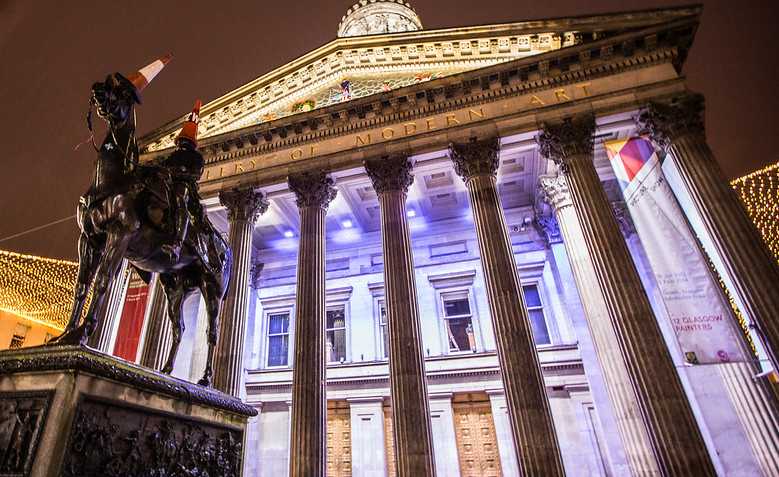 Wellington statue with traffic cones in front of what was slaver William Cunninghame's home. Source: Flickr - Tony Webster
Wellington statue with traffic cones in front of what was slaver William Cunninghame's home. Source: Flickr - Tony Webster
Christine Whyte reports on the growing movement of resistance to the slave traders and colonialists commemorated on Glasgow’s streets
On the streets of Glasgow, statues of men who condoned enslavement, perpetrated imperial violence, and profited from empire loom over pedestrians. One of them is a tourist icon, the permanently traffic-coned Duke of Wellington. The statue and its location are a ‘perfect storm’ of noxious slavery and imperial legacies. It is situated in Glasgow’s Royal Exchange Square, where contracts on commodities were exchanged in the 19th century. These included valuable deals on slave-grown cotton, or in Scottish linen-bound to make clothing for enslaved people.
When the statue was erected in 1844, the building behind it had not long been converted from the first Glasgow branch of the Royal Bank of Scotland to the Royal Exchange. Before that though, it had been the mansion of enslaver and plantation owner William Cunninghame. Literally the master’s house.
In many ways, Glasgow has been ahead of most UK cities in reckoning with its slavery past. There is a long-standing campaign to establish a Museum of Slavery, Empire and Migration led by a local anti-racist organisation (the Coalition for Racial Equality and Rights), popular SNP City Councillor Graham Campbell has been vocal on the topic for many years, and both the university and the City Council have commissioned research by historian of Atlantic slavery, Dr. Stephen Mullen. In addition to these formal programmes, various creative interventions have highlighted Scotland’s links to slavery, performances, and artwork by Tawona Sithole and Gameli Tordzro in 2007 to The Empire Café. In 2014, a street-based play ‘Emancipation Acts’ culminated in a finale in front of Cunninghame’s mansion, now the city’s Gallery of Modern Art.
But the statue in the square serves as a reminder of how slavery and empire occupied the same stage, with many of the same players. The Duke of Wellington himself was involved in the colonial suppression of both Ireland and India. The pictorial plaques surrounding the statue’s plinth depict scenes of colonial violence at eye level, while Wellington, on his horse, towers high above. At this point then, where Wellington looks down Ingram Street (named for another slave-trader) towards Glasgow’s ritzy ‘Merchant City’, memorialisation of the imperial conquest of Asia and slavery in the Caribbean converge. It converges also in the Scottish families where one son went west on slave ships to work on plantations, and another son east to make a fortune in colonial loot with the East India Company.
This is a legacy that will be more difficult to confront directly. It is not only the scale of imperial dispossession; it is its entanglements. Wealth from India was invested into land, factories, houses, and farms, as were the profits of slavery. But they also found their way into cultural institutions, museums, schools, universities, and galleries. And money from the Caribbean crossed the Indian Ocean to fund empire-building, and vice versa. Untangling Scotland’s position in this web will be difficult, but necessary.
The statue of Wellington has become a symbol of the city, but not as an imposing reminder of the empire. His fame now comes from his jaunty traffic cone hat. It is a joke, told by drunks, at the expense of the police who have sought endlessly to stop them. From plans to spend tens of thousands to raise the plinth, to testing a million-pound CCTV system to automatically detect the placing of the traffic cone, the police have tried and failed to stop Glaswegians from mocking this pompous symbol. In the past week, the cone took on a more serious function, bearing the Black Lives Matter slogan. In the surrounding streets, the names of slave traders were replaced with Black activists, martyrs, and leaders, by Celtic Football Club supporters. And now, Glaswegians are calling again for a reckoning with the city’s past, they are resisting a future of violent policing and they are organising to confront racism. Wellington’s traffic cone is a small, but potent, symbol that the police do not always have the upper hand when the people are determined enough. The protestors on Glasgow Green on Sunday can take this demonstration of love and unity forward to create new institutions that centre the liberation struggles of Black activists and are founded with conscious anti-racist politics.
Christine Whyte is a historian of West Africa, particularly interested in the history of slavery and its abolition. She teaches at the University of Glasgow.
Join Revolution! May Day weekender in London
The world is changing fast. From tariffs and trade wars to the continuing genocide in Gaza to Starmer’s austerity 2.0.
Revolution! on Saturday 3 – Sunday 4 May brings together leading activists and authors to discuss the key questions of the moment and chart a strategy for the left.

